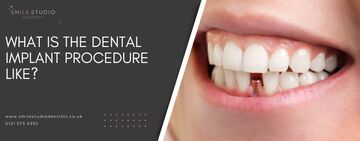
Dental Implants — A Permanent Solution to Missing Teeth
12.03.2024
One of the biggest advancements in dental treatment in recent years is the rise of the dental implant. While this treatment option may have been around for a while, it has recently become more accessible and more popular. With more dentists offering the treatment and the cost of materials falling, it’s becoming a more affordable treatment option to consider.
Dental implants are the only way to restore the functionality of a missing tooth. While other treatment options might address the issue from an aesthetic perspective, no other restorative treatment plan can truly restore the function of a missing tooth.
In this guide, we’re looking at the role of dental implants for replacing missing teeth, including everything you need to know about the treatment from start to finish.

What are dental implants?
Dental implants are titanium screws that are placed in the jawbone and then used to support a restoration such as a crown for a single missing tooth, a bridge for multiple missing teeth, or an entire arch to replace dentures.
This treatment is unique as it uses your jaw bone to support the restoration, which allows the implant to mimic the role of a tooth root. By replacing the tooth root with an artificial root, the force of the bite is absorbed by the jaw bone rather than the surrounding teeth or gums. This helps to prevent bone loss in the jaw which can lead to changes in the face shape.

Who is a good candidate for dental implants?
To be a good candidate for dental implants, you need to have good overall oral health. This would typically mean you have no signs of gum disease and you are able to take good care of your remaining teeth and the dental implant.
There are some lifestyle choices and conditions that could make you unsuitable for dental implants. If you have osteoporosis and a loss of bone density, you might not be a good candidate for this treatment as your jaw might struggle to support the implant.
Smokers would also be unsuitable for the treatment, as smoking will increase the risk of rejection. Some radiation treatments and medications could also make you unsuitable for this treatment.
If you’re curious about dental implants and want to know if you are a suitable candidate, the best option is to book a consultation with your dentist to learn more.

What is the dental implant procedure like?
The dental implant procedure should be no more painful or uncomfortable than an extraction. It takes place in multiple parts over a few months, as your implant will need time to heal between the steps. The steps can be broken down as follows:
Placing the implant
Your dentist starts by making a small pocket in your jaw bone and placing the dental implant inside. The gum above the implant is sutured closed and the implant is left to heal. The jaw bone will fuse to the implant in a process known as osseointegration. This provides a solid foundation for the crown, bridge or denture.
Placing the healing abutment
When your dentist is satisfied that the implant is sufficiently healed, you will return to the practice for the second stage. Your dentist exposes the top part of the implant and attaches a healing abutment. This sits above the surface of your gum line. The gum is then contoured to create a natural-looking finish.
Placing your crown
The final stage of the treatment plan is to place the crown, bridge or denture on the healing abutment. This completes the restoration and you will be able to eat, speak and smile with confidence again. The implant will be load-bearing as soon as the final restoration is placed. It might take some time to get used to the new sensations of the restored tooth.

What is aftercare like for dental implants?
The treatment plan takes place over multiple months, and you will need to be aware of the aftercare requirements at each stage. Good oral hygiene is essential throughout the treatment process to ensure the implant is not rejected. The most common issue faced during the treatment plan and after treatment is a condition known as peri implantitis.
This occurs when an infection is present in the socket which causes the implant to come loose. If this happens, the implant may need to be removed and it may not be possible to replace it due to bone loss.
Good oral hygiene is the best way to protect your oral health after treatment. During your initial consultation, you can speak to our dental hygienists for advice and support on the best ways to care for your teeth before, during and after treatment.
If you’re ready to start your dental implant journey, get in touch with our team today.